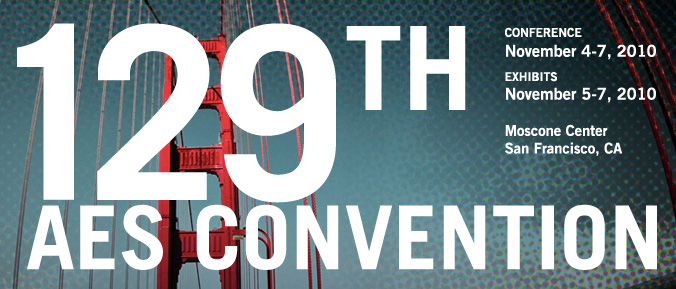
AES San Francisco 2010
Paper Session P12
P12 - Virtual Rooms
Friday, November 5, 2:30 pm — 5:30 pm (Room 236)
Chair:
Jean-Marc Jot
P12-1 Assessing Virtual Teleconferencing Rooms—Mansoor Hyder, Michael Haun, Olesja Weidmann, Christian Hoene, Universität Tübingen - Tübingen, Germany
Spatial audio makes teleconferencing more natural, helps to locate and distinguish talkers in a virtual acoustic environment, and to understand multiple talkers. This paper presents a study on how to design virtual acoustic environments used in 3-D audio teleconferences to maximize localization performance, easiness, and subjective speech quality ratings. We conducted subjective listening-only tests considering different parameters describing the virtual acoustic environment, including acoustic room properties, virtual sitting arrangements, reflections of a conference table, number of concurrent talkers and different voice types of call participants. The experimental results help us to enhance the performance of our open-source, spatial audio teleconferencing solution named "3DTel" by enhancing the quality of its user experience in terms of naturalness and speech quality.
Convention Paper 8221 (Purchase now)
P12-2 Stereo Acoustic Echo Cancellation for Telepresence Systems—Shreyas Paranjpe, Scott Pennock, Phil Hetherington, QNX Software Systems Inc. (Wavemakers) - Vancouver, BC, Canada
A Telepresence system provides its users the sense that they are virtually present in another physical location. Typically, this means providing a high quality audio and video communication path. Simply adding video communication to typical audio teleconferencing is not enough. When users see each other, they quickly realize the poor audio performance, such as half duplex behavior, that is commonly implemented. In order to make affordable Telepresence systems for everyone, the challenge is to design high performance audio communication systems that are computationally efficient.
Convention Paper 8222 (Purchase now)
P12-3 Early Energy Conditions in Small Rooms and in Convolutions of Small-Room Impulse Responses—U. Peter Svensson, Hassan El-Banna Zidan, Norwegian University of Science and Telecommunications - Trondheim, Norway
A simplified prediction model for the early-to-late energy ratio has been tested for small rooms that are typically used in video conferences. Measurements have been carried out in a few rooms and early- and late-energy levels have been compared with predictions according to Barron's model and predicted octave-band levels are typically within 1-2 dB of measured values. Measured impulse responses are then convolved to simulate a video conference setup, and simplified predictions of the early and late energy conditions of convolved impulse responses are compared with (convolved) measurements.
Convention Paper 8223 (Purchase now)
P12-4 A Convolution-Based System for Virtual Acoustic Support of Performing Musicians—Wieslaw Woszczyk, Doyuen Ko, Brett Leonard, McGill University - Montreal, Quebec, Canada
Musicians performing on stage need to hear a proper balance of themselves and other players in order to achieve a good sense of ensemble and musicality. Their ability is influenced by the quality of the acoustic response of the room. In spaces where the existing acoustic conditions are detrimental to good communication on stage, ‘electronic architecture’ may be used to rebuild the acoustic support for musicians. A system is developed that utilizes measured impulse responses from a variety of superior acoustic spaces to generate, using near zero-latency multichannel convolution, an artificial sound field augmenting that already present. This method of virtual acoustic technology does not amplify (or use again) the energy produced by the existing room; instead it generates desirable room response components from other measured spaces. The adjustable acoustic conditions are set using a comprehensive GUI, transducer arrays, and a layered system architecture.
Convention Paper 8224 (Purchase now)
P12-5 Simulating Hearing Loss in Virtual Training—Ramy Sadek, David Krum, Mark Bolas, University of Southern California Institute for Creative Technologies - Playa Vista, CA, USA
Audio systems for virtual reality and augmented reality training environments commonly focus on high-quality audio reproduction. Yet many trainees may face real-world situations wherein hearing is compromised. In these cases, the hindrance caused by impaired or lost hearing is a significant stressor that may affect performance. Because this phenomenon is hard to simulate without actually causing hearing damage, trainees are largely unpracticed at operating with diminished hearing. To improve the match between training scenarios and real-world situations, this effort aims to add simulated hearing loss or impairment as a training variable. The goal is to affect everything users hear—including non-simulated sounds such as their own and each other’s voices—without overt noticeability, risk to hearing, or requiring headphones.
Convention Paper 8225 (Purchase now)
P12-6 OpenAIR: An Interactive Auralization Web Resource and Database—Simon Shelley, Damian T. Murphy, University of York - Heslington, York, UK
There have been many recent initiatives to capture the impulse responses of important or interesting acoustic spaces, although not all of this data has been made more widely available to researchers interested in auralization. This paper presents the Open Acoustic Impulse Response (OpenAIR) Library, a new online resource allowing users to share impulse responses and related acoustical information. Open-source software is provided, allowing the user to render the acoustical data using various auralization strategies. Software tools and guidelines for the process of impulse response capture are also provided, aiming to disseminate best practice. The database can accommodate impulse response datasets captured according to different measurement techniques and the use of robust spatial audio coding formats is also considered for the distribution of this type of information. Visitors to the resource can search for acoustical data using keywords and can also browse uploaded datasets on a world map.
Convention Paper 8226 (Purchase now)
